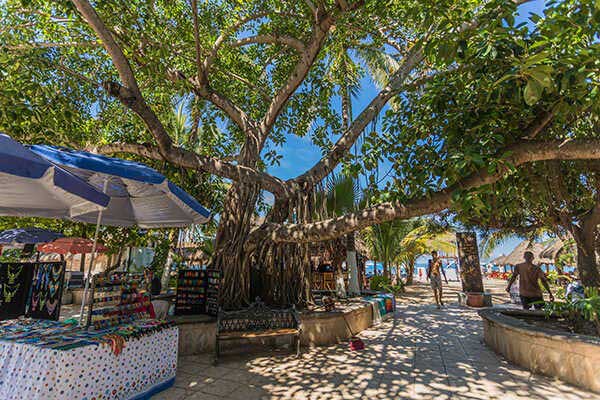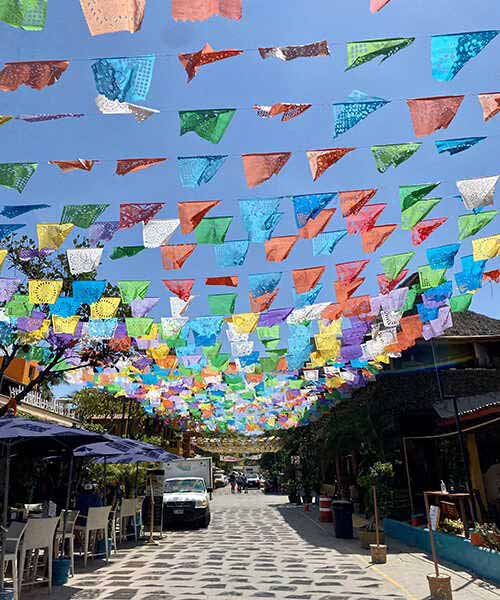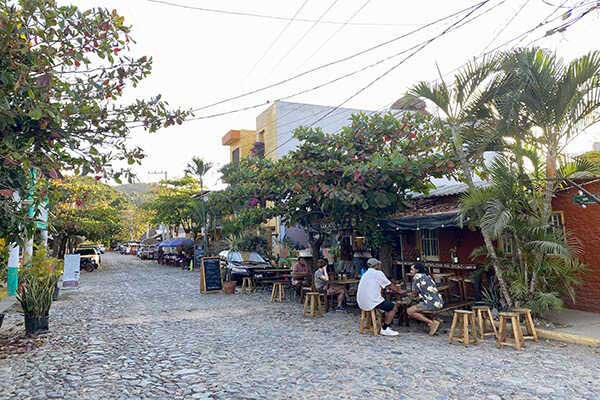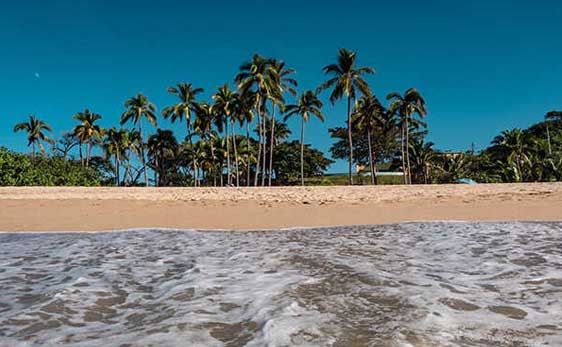Expat Guide to San Pancho, Mexico (San Francisco Nayarit)
The long, cold winter was finally getting the best of me, so I flew south to Sayulita, Mexico for a week to fill up on vitamin D and sea and maybe to eat a taco or 20. It was my first time ditching out of winter to Mexico, and after a quick flight to Puerto Vallarta and an hour bus ride to Sayulita, I was standing barefoot in the sand with a beer in my hand, watching the sunset over the Pacific, wondering why I hadn’t been doing this for the last 15 years.
Sayulita is a gem, but it’s no secret. Expats have not only discovered the laid-back lifestyle and semi-tropical climate only a few hours’ flight south of the border, but many have decided to spend half the year living in it. I soon embraced the easy living in Sayulita and everything it had to offer. The weather was perfect (70 F every day), locals were genuinely friendly, the food was amazing, cost of living was cheap, the beach was clean, and the surf break was the real deal. I could see myself living there half the year too and began planning on how I could make that happen. But when I talked to expats, there was one thing I heard again and again from them: “If you want a more authentic Mexican feel,” they said, “if you want to see Sayulita before the expat invasion, go north to San Pancho.”
A Lesser-Known Coastal Town

Before you start searching for San Pancho on google maps, know that in Mexican tradition, Pancho is commonly a nickname for Francisco (see: Francisco “Pancho” Villa). The same apparently goes for towns too. So keep that in mind when you’re at the bus station in Sayulita waiting for your bus that never seems to arrive. Or you know, just skip Sayulita altogether, book an apartment in San Pancho for two weeks, and grab a “compostela” bus from the airport in Puerto Vallarta that gets you there in an hour for two bucks.
Sure, Sayulita has 50 restaurants and as many bars; a French bakery and organic coffee; surfboard rentals and massage tables; wine tastings and jazz nights; a modern hospital and a veterinary clinic; but—for me—it also feels a bit too tourist-friendly, and just too “easy.” San Pancho has a dozen great restaurants, a handful of hip cafes and bars, two solid breweries, a diverse art scene, live music in the evenings, apartments by the sea, and just like Sayulita, a surf break on a clean beach. The difference between the two is that San Pancho is smaller-scale, slower-paced, and feels like Mexico. The expat influence is there, but the impression isn’t as deep.

The main avenue in San Pancho runs east/west and the further you get away from the beach, the closer you get to the Mexico we romanticize: rusty old trucks parked along dusty dirt roads with beds full of tomatoes for sale; brightly-colored cantinas tucked between rows of cinder block houses; tiny gray-haired women turning full chickens with tongs as they sizzle over charcoal grills; lazy dogs sleeping away the afternoon in the shade of palm trees; a straw-hatted old paletero ringing the bell attached to his fruit popsicle cart as he pushes it slowly along the uneven sidewalk; kids dressed in school uniforms kicking beat up soccer balls in the street or mobbing the candy vendor at his post outside the gates of the school; a large soccer field packed with friends and families watching uncles and nephews sprint after the ball under the white stadium lights while music blares from a ramada; all of this exists in San Pancho just as it has since before the first expat set foot in this magical place however many years ago. If it wasn’t for the breweries, creperies, and sushi spots near the beach, you would think San Pancho was still off the tourist map, and after 15 minutes of exploring the town, one gets the feeling that local Panchos want it to remain that way.
[mexico_signup]
Nature & Wildlife in San Pancho

San Pancho is taking a more thoughtful and conservative approach to the expat influx. The town feels as if it was built with a naturalist’s eye and a conservationist’s heart. Public parks thick with native flora don’t just dot the town but consume entire parts of it. Giant strangler figs and parota trees line the streets, casting giant shadows with their massive trunks and cooling entire blocks with their dense foliage. Front yards filled with wild almond trees, magnolias, and purple-flowering jacarandas dazzle the senses from above, while vibrant marigolds, spider lilies, and ruby bundleflowers fill in the spaces in between, giving one the feeling that San Pancho wasn’t built in the jungle but is a part of the natural world, grown harmoniously from the jungle floor.
Wildlife abounds in San Pancho, especially birds. A serene lagoon only meters from the sea is an important stop for migrating birds and a picturesque home to herons, gulls, egrets, and grebes who can be found dipping their beaks in water lilies and duck-potatoes in search of lunch; orioles, hummingbirds, flycatchers, and hawks flitter, glide, hover, and soar through the neighborhood canopies; and deeper in the jungle, Mexican parrotlets, orange-fronted parakeets, and lilac-crowned amazons elude those attempting to check all 300 bird species found in San Pancho off their list.
And then there’s the turtles. The beach at San Pancho has been a popular nesting area for olive ridley sea turtles for millenia (decades ago there were so many hatchlings on the beach, locals had to tiptoe and wind their way to the water at night), but due to commercial harvesting, the population dropped to levels nearing extinction. Starting in the 90s, conservation efforts led by a few concerned Panchos (Grupo Ecológico de la Costa Verde) boosted the number of dwindling nests from well below 100 to numbers now nearing 2,000–an incredible turnaround and a fitting example for a town that still retains a respect for the land and the sea, even when the temptation of four-story hotels, condominium complexes, golf resorts, and the affluence that accompanies them knock.
Where to Eat in San Pancho

That’s not to say that San Pancho is some “off-the-beaten-path,” tourist-free enclave on the Nayarit Peninsula (for that you have to go even further north). You’ll find plenty of restaurants to cater to any craving you have. Beginning only a few blocks from the beach, San Pancho is 100% catered to tourists, and if one were to be dropped off in a taxi underneath the colorful flags fluttering above the street, they would think they were on Calle Delfines in Sayulita. A barbeque joint, seafood and Italian restaurants, steakhouses, and a bakery all advertise daily specials as you begin your walk down the avenue; a karaoke bar and a dozen others beckon you in with Bob Marley, Bob Dylan, and Bobby McFerrin; and cafes that sell local organic coffee and ice-cold cacao agua fresca invite you to sit on their shaded terraces and use their free Wi-Fi during the hot afternoons after your surfing lessons or massage.
Off the main drag you’ll find Arigato, a single-counter restaurant run by a Canadian/Japanese woman and her Argentinian husband specializing in handmade sushi wrapped in Japanese nori, lomitos (Argentinian sandwiches), a fancy cheese plate consisting of local creamy selections, and a selection of homemade brews. Find your way there in the evening and enjoy a crisp Czech-style pilsner or hazy IPA. After the sun goes down and the temperature falls to a brisk 68 F, order a carrot cake baked daily and the chocolate stout and then stroll back to your casita.
Best Places to Stay in San Pancho

As for places to stay, hotels are plentiful next to the beach, with terraces looking out over the endless Pacific, and Airbnbs are available throughout the town. I recommend finding one off the main avenue, ideally across the street from Arigato or Cerveceria Artesanal San Pancho, where you can make friends over a few craft beers with locals and expats who can tell you about San Pancho when it was a quiet fishing village nowhere to be found on the tourist map. Even though those days are gone, San Pancho is still a relatively quiet and lesser-known slice of paradise. But the word is getting out, and with Sayulita a well-established expat hotspot, it seems inevitable that San Pancho will begin gaining popularity. Get there soon so that one day you’ll be the one telling potential expats over a few beers that they’re 15 years too late.
[mexico_signup]
How to Get to San Pancho

Getting there: Direct flights to Puerto Vallarta depart daily from a number of U.S. cities. After exiting the airport, a line of taxis will offer to drive you to your destination, be it Sayulita, San Pancho, or any other coastal town. Most will charge up to $100 for a one-way ride. I recommend taking the local “compostela” bus outside the airport and over the pedestrian bridge; the ride only takes about 20 minutes longer than a taxi and it’s a more authentic experience that provides ample people-watching opportunities. Someone at the bus stop (usually a 12-year-old kid) will help you board the correct bus. Consider breaking up your big bills at the Oxxo so you don’t create a scene on the bus for your $2 ticket.
If you aren’t sure about committing to San Pancho and wish to stay in Sayulita instead, there are hourly buses from the bus station in Sayulita to San Pancho and of course taxis too. If you’re up for a nice walk, you can follow the beach from Sayulita north, up and around the bluff, and then along the secluded sandy beach for two miles until you reach a path that takes you into the jungle and then quickly down to the beach at San Pancho (it really isn’t as difficult as I made it sound). Bring sunscreen, water, and snacks.
Featured Image Copyright: ©Yann Morel/iStock

